Climate Change Plan: monitoring report 2018
The first annual report monitoring progress towards Scotland's Climate Change Plan.
Buildings
Greenhouse gas emissions from the buildings sector have already been reduced by 13% (1990 to 2016). The Climate Change Plan sets out policies and proposals to reduce emissions from this sector by a further 33% (2018 to 2032). The Plan sets out the following four policy outcomes for the sector:
1. By 2032, the energy intensity of Scotland’s residential buildings will fall by 30% on 2015 levels.
2. By 2032, the emissions intensity of residential buildings will fall by at least 30% on 2015 levels.
3. By 2032, non-domestic energy productivity to improve by at least 30% on 2015 levels.
4. By 2032, the emissions intensity of the non-domestic sector will fall by at least 30% on 2015 levels.
The long-term trend shows that the emissions intensity of Scotland’s residential buildings has fallen by 31% between 1998-2016, while energy intensity in the residential sector has fallen by 27% between 2005 and 2016. The energy productivity of the non-domestic sector is improving, which corresponds with a declining emissions intensity, which has fallen by 49% between 1998 and 2016. Space heating is a significant driver of emissions in the residential sector. As such, it can be affected by fluctuating external temperatures. This is demonstrated in recent winters, which have been on average cooler, leading to increased emissions. Due to this year-on-year variation it is the long-term trend that is important.
The Energy Efficient Scotland Route Map was published in May 2018 setting out our vision for 2040 where our homes and buildings are warmer, greener and more efficient. The Route Map sets out the steps we will take over the next 20 years to reduce emissions from Scotland’s buildings, including:
- proposals for a long-term framework of energy efficiency standards for both domestic and non-domestic sectors, including the aim for all homes to achieve an Energy Performance Certificate rating of at least band C by 2040, where technically feasible and cost-effective;
- further details regarding our offer of support to owners of residential and non-domestic properties; and
- the launch of the Energy Efficient Scotland Transition Programme which builds on our existing area-based schemes and extends these to households who will self-fund improvements to their homes as well as to businesses and the third and public sectors.
Progress is being made to turn policy proposals into policy, including:
- Review of energy standards within building regulations has commenced. This seeks to further reduce energy demand and greenhouse gas emissions in new building and where new building work is undertaken to existing buildings. A call for evidence published in June sought views on the implementation of the previous 2015 standards and the potential for further cost-effective improvement. Responses are now being considered.
- Review of The Assessment of Energy Performance of Non-Domestic Buildings (Scotland) Regulations 2016 will commence following analysis of the responses to our consultation on Energy Efficient Scotland. The programme for this first review is set out in the Route Map, proposing consultation on amended regulations in 2019, publication in 2020 and application from 2021.
- Decisions on the decarbonisation of the gas grid are reserved to the UK Government. We continue to work with the UK Government and our partners, including local authorities and utility providers on the best approach to decarbonising the gas grid. The UK Government published its call for evidence titled A Future Framework for Heat in Buildings in March. We expect the UK Government to respond in due course.
- Decisions on any alternative to the UK Government Renewable Heat Incentive Scheme, which is due to end in 2021, are matters that are reserved to UK Ministers under the Scotland Act 1998. The UK Government has not as yet indicated an alternative renewable heat subsidy scheme to replace RHI. The Scottish Government continues to liaise with the UK Government for clarity on this matter.
Output Indicator For Policy Outcome 1:
Change in energy intensity of residential buildings from 2015.
| 2020 | 2025 | 2032 | |
|---|---|---|---|
| Change in energy intensity from 2015 | -10% | -17% | -30% |
Most Recent Data: 17.0MWh per household in 2016.
Baseline Data: 17.2MWh per household in 2015.
Change: 1.0% decrease in energy intensity in 2016.
Data Source(s): Total final energy consumption at regional and local authority level (Department for Business, Energy and Industry Strategy)[1]. Estimates of households and dwellings in Scotland, 2017 (National Records of Scotland)[2].
On Track: Too early to make assessment.
Commentary:
Buildings Figure 1: Relative Changes in Energy Intensity of Residential buildings (MWh per household), 2005 to 2016 (2015 = 100)
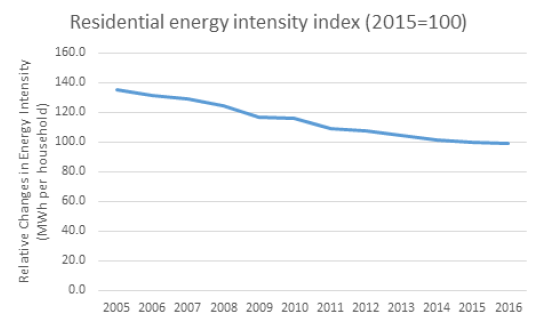
- Energy intensity of residential buildings has fallen 1.0% between 2015 and 2016. It has been steadily falling since 2005 and has fallen by 27% since the first available consumption data in 2005. This decrease over time is due to both a general trend of decreasing energy consumption and increasing household numbers.
Output Indicator For Policy Outcome 2:
Change in emissions intensity of residential buildings from 2015.
| 2020 | 2025 | 2032 | |
|---|---|---|---|
| Change in emissions intensity from 2015 | -5% | -13% | -30% |
Most Recent Data: 2.58tCO2e per household in 2016.
Baseline Data: 2.51tCO2e per household in 2015.
Change: 3.0% increase in emissions intensity between 2015 and 2016.
Data Source(s): Scottish Greenhouse Gas Emissions (Scottish Government)[3] Estimates of households and dwellings in Scotland, 2017 (National Records of Scotland)[2].
On Track: Too early to make assessment.
Commentary:
Buildings Figure 2: Relative Changes in Emissions Intensity of Residential buildings (tCO2e per household), 1998 to 2016 (2015=100)
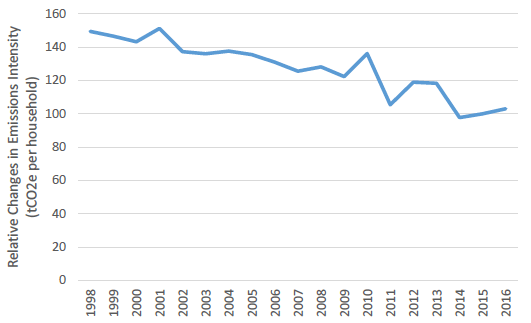
- Residential emissions intensity has fallen 31% between 1998 and 2016, although it varies annually, mainly driven by fluctuating external temperatures.
- Between 2015 and 2016 emissions intensity in the residential sector increased by 3.0%. This is linked to an increase in the combustion of fuel in households, reflecting cooler mean winter and autumn temperatures in 2016 compared to 2015.
- Despite the increase between 2015 and 2016, the overarching trend of emissions intensity shows a decrease. There have been prior years which have seen a slight increase before continuing a downward trajectory, with notable instances in 2008 and 2010. The rise in emissions in 2015 and 2016 is the first instance in which there has been an increase two years in a row, but it remains too early to make an assessment as to whether or not this will continue.
Output Indicator For Policy Outcome 3:
Change in non-domestic energy productivity from 2015.
| 2020 | 2025 | 2032 | |
|---|---|---|---|
| Change in energy productivity from 2015 | 10% | 20% | 30% |
Most Recent Data: £2.20 million Gross Value Added (GVA) per GWh in 2016.
Baseline Data: £2.23 million GVA per GWh in 2015.
Change: 1.3% decrease in energy productivity from 2015 to 2016.
Data Source(S):
- Quarterly National Accounts Scotland, Q1 2018[4].
- Total final energy consumption at regional and local authority level (Department for Business, Energy and Industry Strategy)[1].
On Track: Too early to make assessment.
Commentary:
Buildings Figure 3: Relative Changes in Energy Productivity (GVA/GWh), 2005 to 2016 (2015 = 100)
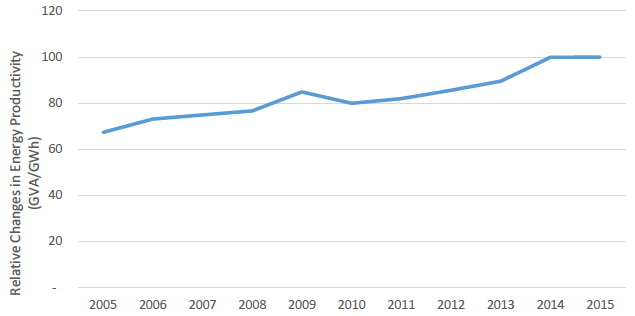
- Between 2005 and 2016 energy productivity in the industrial and commercial sectors in Scotland rose by 45% as a result of an underlying 25% fall in energy consumption and a 9% increase in GVA (2016 prices) during this time.
- Energy productivity fell 1.3% between 2015 and 2016, which is the first decrease in this measure since 2010, and which follows steady increases since 2005, as outlined in Buildings Figure 3. The reduction in this period was largely due to increases in energy consumption in 2016, the first increases in consumption in these sectors since 2010, coupled with moderate levels of growth in output.
Output Indicator For Policy Outcome 4:
Change in emissions intensity of non-domestic sector from 2015.
| 2020 | 2025 | 2032 | |
|---|---|---|---|
| Change in emissions intensity from 2015 | -10% | -20% | -30% |
Most Recent Data: 113.2tCO2e per £million GVA in 2016.
Baseline Data: 112.9tCO2e per £million GVA in 2015.
Change: 0.3% increase in emissions intensity from 2015 to 2016.
Data Source(s):
On Track: Too early to make assessment.
Commentary:
Buildings Figure 4: Relative Changes in Emissions Intensity (tCO2e/£ millions), 1998-2016 (2015=100)
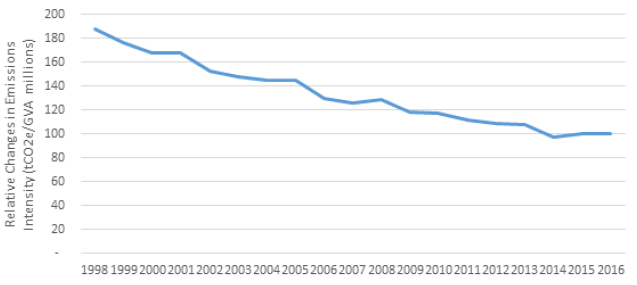
- Between 1998 and 2016 emissions intensity fell by 47%, as a result of an underlying 32% fall in emissions and a 35% increase in GVA (2016 prices). The majority of the reduction in emissions during this period came from industry (over 6MtCO2e, a 37% fall) rather than services (0.2MtCO2e, a 5% fall).
- Emissions intensity increased by 0.3% between 2015 and 2016, driven by an increase in emissions across both industry and services. Despite this increase, the sectors are following an overarching trend of decreasing emissions intensity, as outlined in Buildings Figure 4, and at this stage it remains too early to make an assessment as to whether this long-term indicator is on track.
Implementation Indicator For Policy Outcomes 1, 2, 3 And 4:
Average energy efficiency levels of domestic buildings increases.
Most Recent Data: Average energy efficiency rating (SAP 2012) of 63.7 in 2016.
Baseline Data: Average energy efficiency rating (SAP 2012) of 62.8 in 2015. Change: +0.9 SAP points between 2015 and 2016, a statistically significant change.
Data Source(s): Scottish House Condition Survey, a National Statistics publication. The Scottish House Condition Survey is the largest single housing research project in Scotland, and the only national survey to look at the physical condition of Scotland’s homes as well as the experiences of householders. The latest Scottish House Condition Survey publication relates to 2016 can be found at the following link: http://www.gov.scot/Publications/2017/12/5401[5]. Survey data for the year 2017 will be released in December 2018.
Energy efficiency ratings are calculated under two versions of Standard Assessment Procedure (SAP), the SAP 2009 methodology and the most recent SAP 2012 methodology. Using SAP 2009 enables us to examine the trend in the energy efficiency of the housing stock since 2010. SAP 2012 was first used in reporting data from the Scottish House Condition Survey in the 2014 Key Findings report and therefore only three years’ of data are available. Further information about SAP and the differences between the two methodologies can be found in the link above.
Commentary:
An increase in the average energy efficiency of domestic buildings will contribute to reducing energy intensity and emissions intensity in the residential sector.
We are able to explore long-term improvements in the average energy efficiency of the Scottish housing stock using SAP 2009. Over the period 2010 to 2016, the average energy efficiency rating increased from 59.9 to 65.1. This is demonstrated in the chart below and highlights that Scottish housing is gradually moving up through the Energy Performance Certificate bands.
Buildings Figure 5: Average (mean) energy efficiency rating of Scottish housing (SAP 2009)
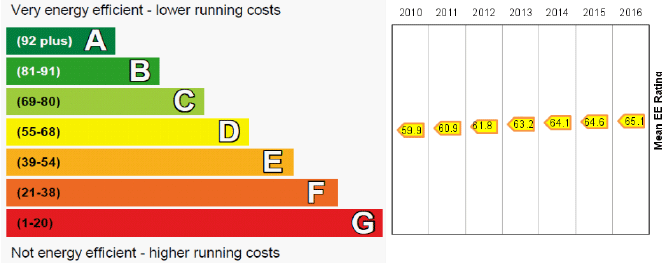
The data presented for this indicator are the mean energy efficiency rating. The median rating in 2016 was 66 (SAP 2012) indicating that half of the housing stock has an energy efficiency rating of 66 or better. Based on SAP 2009, we can also see that the median rating has improved over time, increasing from 62 in 2010 to 67 in 2014 and then remaining at that level in 2015 and 2016.
Implementation Indicator For Policy Outcomes 1, 2, 3 And 4:
Grouped domestic energy efficiency ratings improve.
Most Recent Data: 39% of dwellings rated as Energy Performance Certificate (EPC) band C (SAP 2012) or better in 2016.
Baseline Data: 37% of dwellings rated as EPC band C (SAP 2012) or better in 2015.
Change: There was no statistically significant difference between 2015 and 2016 in the percentage of dwellings rated as EPC band C or better.
Data Source(s): Scottish House Condition Survey (as per previous implementation indicator)[5].
Commentary:
Buildings Figure 6: Grouped EPC Bands under SAP 2009 and SAP 2012, 2010-2016
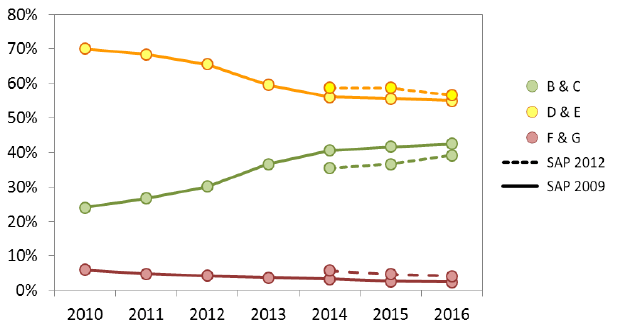
Although there was no statistically significant difference between 2015 and 2016 in the percentage of dwellings rated as EPC band C or better, there is a long-term improvement in the energy efficiency of the Scottish housing stock. Based on SAP 2009, there has been a 77% improvement in the share of the most energy efficiency dwellings from 24% rated C or better in 2010 to 43% in 2016. In the same period, the proportion of properties in the lowest EPC bands (E, F or G) has almost halved, reducing from 27% to 14%.
An improvement in the energy efficiency profile of the domestic building stock will contribute to reducing energy intensity and emissions intensity in the residential sector.
Implementation Indicator For Policy Outcomes 1, 2, 3 And 4:
Percentage of domestic properties with loft and wall insulation increases.
Most Recent Data: 65% of lofts had at least 200mm of loft insulation while 58% of dwellings had wall insulation (cavity or solid) in 2016.
Baseline Data: 64% of lofts had at least 200mm of loft insulation while 56% of dwellings had wall insulation (cavity or solid) in 2015.
Change: There was no statistically significant difference between 2015 and 2016 in the percentage of dwellings with 200mm or more of loft insulation or with insulated walls.
Data Source(s): Scottish House Condition Survey (as per previous implementation indicator)[5]*.
Commentary:
Buildings Figure 7: Depth of loft insulation (where applicable) 2003/04 - 2016
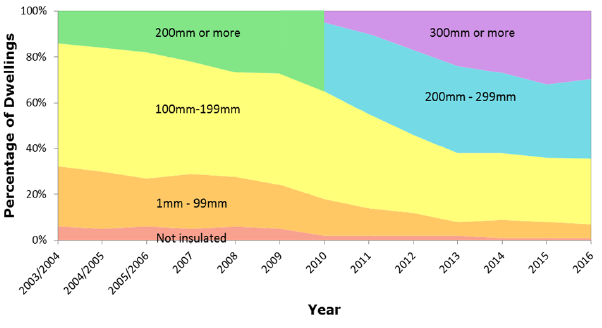
* The presence of cavity wall insulation is becoming increasingly difficult for Scottish House Condition Survey surveyors to identify as over time the injection holes age, fade or are covered up by later work. This may mean that the Scottish House Condition Survey under-estimates the number of homes that have had cavity wall insulation installed. Nonetheless, the longer term trends are consistent with administrative data on the number of cavity wall insulation measures installed under the UK Government Carbon Emissions Reduction Target (CERT) and the Energy Company Obligation (ECO).
There was no statistically significant difference between 2015 and 2016 in the percentage of dwellings with 200mm or more of loft insulation or with insulated walls. However, there is long-term improvement on these indicators, with loft insulation increasing from 35% in 2010. Similarly rates of cavity wall insulation have increased from 62% in 2010 to 72% in 2016. 94% of lofts are already insulated to at least 100 mm while the percentage of lofts with a high standard of insulation (300mm or more) has increased from 5% in 2010 to 30% in 2016. Whilst the rate for 2015 was 32%, the difference compared to 2016 is not statistically significant.
An increase in insulation levels will contribute to reducing energy and emissions intensity in the residential sector.
Implementation Indicator For Policy Outcomes 1, 2, 3 And 4:
Total renewable heat generation in Scotland increases.
Most Recent Data: 3,752GWh renewable heat generated in 2016.
Baseline Data: 4,205GWh renewable heat generated in 2015.
Change: 453GWh (11%) decrease in renewable heat generated from 2015 to 2016.
Data Source(s): Renewable Heat in Scotland, 2016, Energy Saving Trust[6].
Commentary:
Buildings Figure 8: Renewable Heat Generated (GWh) - 2010 to 2016
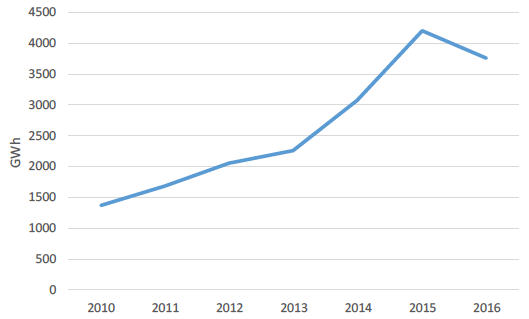
Renewable heat generation fell between 2015 and 2016, mainly driven by changes at a small number of large non-domestic sites, although generation levels remain 2,389GWh higher than in 2010.
An increase in the level of renewable heat generation will contribute to reducing the carbon intensity of Scotland’s heat generation in both the domestic and non-domestic sector.
Implementation Indicator For Policy Outcomes 1, 2, 3 And 4:
Installed capacity of non-domestic Renewable Heat Incentive (RHI) increases.
Most Recent Data: 892MW Installed Capacity In August 2018.
Baseline Data: 729MW installed capacity in August 2017.
Change: 163MW (22%) increase in installed capacity from August 2017 to August 2018.
Data Source(s): Renewable Heat Incentive statistics, Department for Business, Energy and Industry Strategy[7].
Commentary:
- Installed capacity of renewable heat receiving payment under the non-domestic RHI has increased by 112% since December 2015, as outlined in Buildings Figure 9.
Buildings Figure 9: Capacity of accredited non-domestic installations (MW)
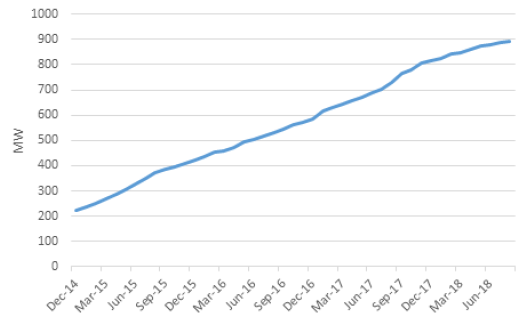
- RHI incentivises renewable heat generation. Increasing the proportion of heat generated renewably will therefore reduce the emissions intensity of heat consumption in Scotland.
- Scotland currently accounts for 21% of all non-domestic accredited installed capacity to the RHI scheme as of August 2018.
- It should be noted that this does not give the full picture of non-domestic renewable installations, only those who have joined the RHI scheme. However, it can be assumed this covers the majority, as the RHI provides an incentive to install renewables.
Implementation Indicator For Policy Outcomes 1, 2, 3 And 4:
Amount of renewable heat paid for under the domestic RHI scheme in Scotland increases.
Most Recent Data: As of end September 2017 around 477GWh of heat had been paid for under the domestic RHI scheme in Scotland.
Baseline Data: As of end September 2016 around 276GWh of heat had been paid for under the domestic RHI scheme in Scotland.
Change: An additional 201GWh of renewable heat was paid for in the year to September 2017.
Data Source(S): Energy in Scotland[8].
Commentary:
As of end September 2017 around 477GWh of heat had been paid for under the domestic RHI scheme in Scotland:
- 323GWh of heat was generated by biomass systems (68% of the Scotland total).
- 108GWh by air source heat pumps (23%).
- 41GWh by ground source heat pumps (9%).
- 4GWh by solar thermal (1%).
Buildings Figure 10: Cumulative domestic RHI heat generation (GWh)
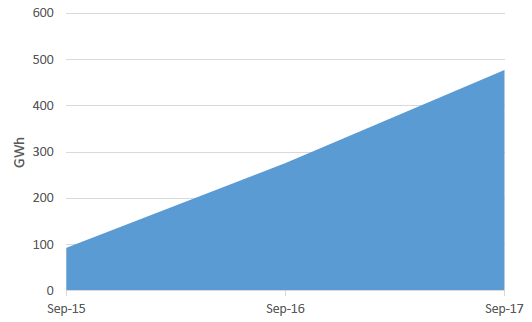
The level of renewable heat supported through the RHI scheme contributes to reducing the emissions intensity of Scotland’s heat generation.
Scotland currently accounts for 20% of all domestic accredited installations to the RHI scheme as of August 2018. Well above pro-rata.
Implementation Indicator For Policy Outcomes 1, 2, 3 And 4:
Further analysis to establish a baseline for non-domestic buildings’ energy efficiency and emissions data.
Commentary:
Analysis has progressed in this area and a non-domestic energy efficiency baseline is due to be published in November 2018.
Using the 30,000 non-domestic Energy Performance Certificates (EPCs) held on the Scottish EPC register, Scotland-wide data sets and building specific electricity and gas meter point data, analysis is being undertaken to establish a baseline for the energy efficiency of Scotland’s non-domestic buildings. This baseline will be essential in helping monitor improvements in energy efficiency and in supporting the development of policies targeted at the non-domestic sector.
Contact
Email: Decarbonisation Division
There is a problem
Thanks for your feedback